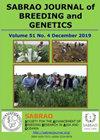UTILIZATION OF GIBBERELLIC ACID (GA3) AND MEPIQUAT CHLORIDE (M.C) AS GROWTH REGULATORS ON MAIZE TO ALLEVIATE SALINITY STRESS
IF 1.7
Q3 PLANT SCIENCES
引用次数: 0
Abstract
Maize (Zea mays L.) is a vital grain crop cultivated globally, which ranks third after wheat and rice. Its consumption in Egypt is primarily for human food, livestock and poultry feed, and raw materials for industrial products, such as, oil and starch. The main environmental factors that limit crop productivity worldwide include salinity, drought, and nutrient imbalance. Plant Growth regulators (PGR), such as, gibberellic acid (GA3) and mepiquat chloride (M.C), reduce the dramatic impacts of salinity and drought on crop growth and yield. This experiment sought to verify the influence of foliar spray application of GA3 and M.C as growth regulators on the growth metrics, chemical components, and maize harvest cultivated in calcareous soil under salinity during the summer of 2021 and 2022, respectively. The following treatments comprised foliar applications of 50 ppm GA3, 100 ppm GA3, 100 ppm M.C, and 250 ppm M.C, applied three times every season. It is clear from the results that foliar application of gibberellic (GA3) and mepiquat chloride (M.C) enhanced growth metrics, biochemical parameters, nutritional content, yield and its components, and oil percentage. After treatment with 100 ppm GA3 and 250 ppm M.C foliar spray, the yield and its constituents and oil percentage achieved the highest shares, with substantial differences between the two treatments. Compared with the control, treatments with 100 ppm GA3 and 250 ppm M.C increased grain yield by 33% and 29.9%, respectively. The study concluded that the most effective therapy for improving maize growth, development, and output under salt stress was 100 ppm GA3 and 250 ppm M.C foliar application during the growth stages. Administering GA3 and M.C mitigated successfully the damage caused by salt stress. Under salinity, gibberellic acid and mepiquat chloride addition increased the growth of maize, chlorophyll content, soluble protein, proline, and the concentration of K+ ions while decreasing the oxidative stress and the accumulation of Na+ ions.利用赤霉素酸(ga3)和氯甲喹(m.c)作为玉米生长调节剂缓解盐胁迫
玉米(Zea mays L.)是全球重要的粮食作物,产量仅次于小麦和水稻。它在埃及的消费主要用于人类食品、牲畜和家禽饲料,以及工业产品的原料,如油和淀粉。在世界范围内,限制作物产量的主要环境因素包括盐度、干旱和营养失衡。植物生长调节剂(PGR),如赤霉素(GA3)和甲草枯氯(M.C),减少盐和干旱对作物生长和产量的巨大影响。本试验旨在验证生长调节剂GA3和M.C分别在2021年和2022年夏季对盐胁迫下钙质土壤玉米生长指标、化学成分和收成的影响。以下处理包括叶面施用50 ppm的GA3, 100 ppm的GA3, 100 ppm的mc和250 ppm的mc,每个季节施用三次。结果表明,叶面施用赤霉素(GA3)和氯甲草枯(M.C)提高了油菜的生长指标、生化参数、营养含量、产量及其组分和出油率。施用100 ppm GA3和250 ppm M.C叶面喷雾处理后,产量、组分和含油率最高,且两种处理间差异显著。与对照相比,100 ppm GA3和250 ppm M.C处理籽粒产量分别提高33%和29.9%。本研究认为,在盐胁迫下改善玉米生长发育和产量的最有效处理是在生长阶段叶面施用100 ppm GA3和250 ppm M.C。施用GA3和M.C成功地减轻了盐胁迫造成的损害。在盐度条件下,添加赤霉素和甲草枯能提高玉米的生长、叶绿素含量、可溶性蛋白、脯氨酸和K+离子浓度,降低氧化应激和Na+离子积累。
本文章由计算机程序翻译,如有差异,请以英文原文为准。
求助全文
约1分钟内获得全文
求助全文
来源期刊

Sabrao Journal of Breeding and Genetics
农林科学-奶制品与动物科学
CiteScore
1.90
自引率
50.00%
发文量
63
期刊介绍:
The SABRAO Journal of Breeding and Genetics is an international journal of plant breeding and genetics research and was first published in 1969. It is the official publication of the Society for the Advancement of Breeding Research in Asia and Oceania (SABRAO).
Its objectives are to: promote the international exchange of research information on plant breeding and genetics, by describing new research findings, or ideas of a basic or practical nature; and be a medium for the exchange of ideas and news regarding members of the Society.
The Journal gives priority to articles that are of direct relevance to plant breeders and with emphasis on the Asian region. Invited for publication are research articles, short communications, methods, reviews, commentaries, and opinion articles. Scientific contributions are refereed and edited to international standards.
The journal publishes articles for SABRAO members mainly. The Journal preferred strongly that at least one author should be a current member of the Society. Non-members may also publish in the journal.
 求助内容:
求助内容: 应助结果提醒方式:
应助结果提醒方式:


